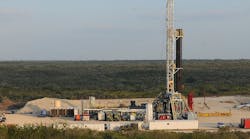Nanotechnology, the control of matter on the atomic and molecular scale, might someday boost the average global recovery factor of oil and gas by 10 percentage points, said an oil company executive at the RMI Oilfield Breakfast Forum in Houston Apr. 8.
Paul Ching, chairman, chief executive officer, and president of Meridian Resource Corp., Houston, described nanotechnology research conducted by the Advanced Energy Consortium (AEC) at the University of Texas at Austin, where he is executive advisor.
Ching said nanosensors have the potential to assess rock and fluid properties from inside the pore spaces of reservoirs.
He estimated the possible gain in average recovery factor, which he put at 28-30% now, in response to a question. Responding to another question, he estimated that commercial use of downhole nanosensors might begin in 5-10 years.
Research in the use of nanotechnology in the oil and gas industry is more advanced for materials and fluids, he noted, predicting an “explosion” in application of the technology in those areas in the next 5 years.
Among other speakers:
- Dan Pickering, copresident of Tudor, Pickering, Holt & Co. Securities, predicted an extended period of business difficulty in the oil and gas business, saying, “This is not a V-bottom environment.”
The market for natural gas, he said, “will get worse before it gets better.”
But a drilling response already in progress in the US foreshadows a gas market turnaround. The weekly average number of rigs drilling for gas has fallen to about 800, only one third of capacity. To keep US gas supply in balance with demand, Pickering said, the gas rig count needs to be 1,000-1,100.
The oil market will rebound before gas, he said. Globally, production at 85 million b/d is 95% of total capacity.
“When demand gets better it’s pretty easy to close up a 5% gap,” he said. “Oil to us feels tighter than gas over the next 3, 4, or 5 years.”
- Derek Mathieson, vice-president and chief technology and marketing officer of Baker Hughes, noted that the oil and gas market strength that ended last year generated “significant growth in technology” and accelerated development from collaboration among service and operating companies.
But the downturn, he said, has created “negative forces” including excessive reductions in technology budgets, layoffs of engineers and scientists, dominance of price in purchase decisions, slow adoption of new technology because of diminished access to drilling sites and fewer collaborative projects, and what he called “management distraction from the value of technology.”
- Steven Newman, president and chief operating officer of Transocean, expressed optimism about long-term prospects for deepwater drilling.
For now, the “midwater” market is “more of a challenge,” he said, although longer term prospects are good “because nobody’s building midwater rigs now.”
He expressed “concern” about the jack up market because demand is decreasing while the supply of rigs continues to increase.
He noted the growing importance of national oil companies for drilling contractors and the industry in general and said that, as they expand operations in their own countries and elsewhere, companies of that type “are looking for more than just a rig.”

